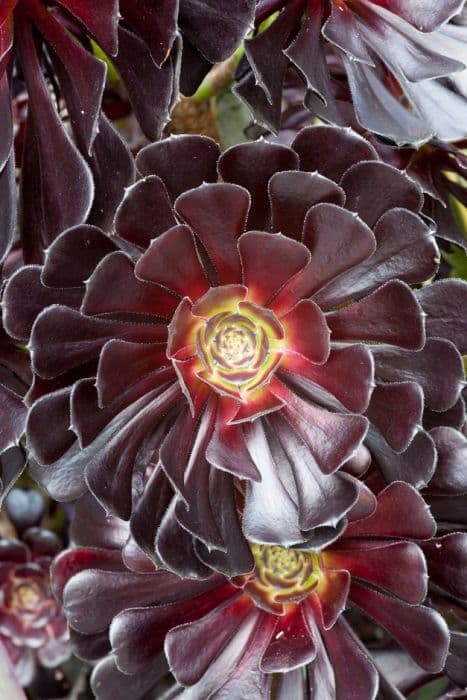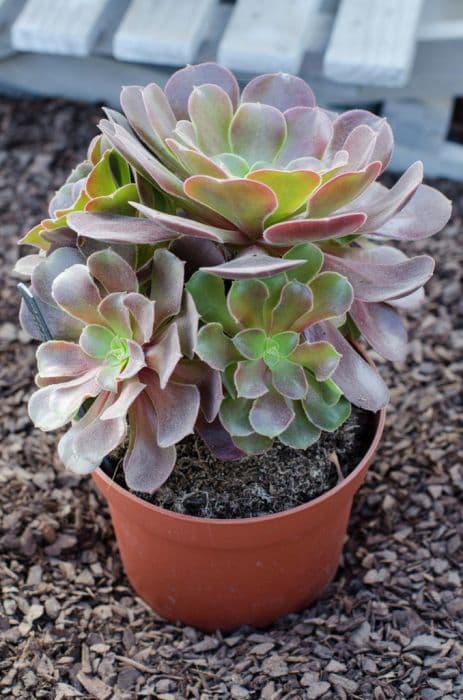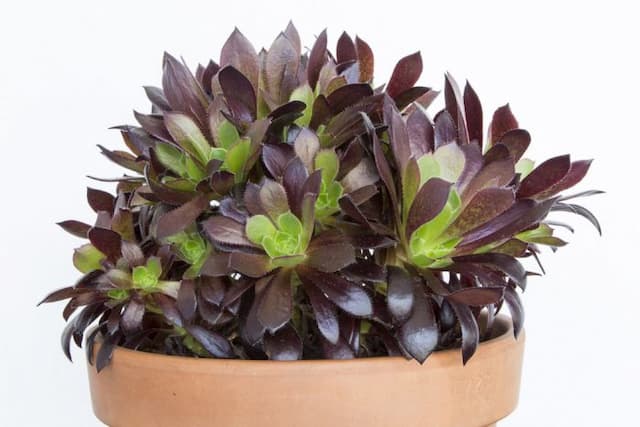Stonecrop Hylotelephium telephium (Atropurpureum Group) 'Purple Emperor'

ABOUT
'Purple Emperor' is a succulent upright perennial that is known for its bold color and texture. The foliage has a rich, deep purple hue, which intensifies to an almost black-purple as the season progresses, particularly when exposed to full sun. The thick, fleshy leaves are arranged in a whorled pattern, giving the plant a full and bushy appearance. These leaves are broad and slightly scalloped at the edges, contributing to the plant's robust look. In late summer to early fall, 'Purple Emperor' produces clusters of tiny, star-shaped flowers. These blossoms are a soft dusty pink to pale red color, contrasting beautifully with the dark foliage. The flowers are held aloft on strong, upright stems above the main body of the plant, attracting pollinators such as butterflies and bees. Even after blooming, the seed heads can provide visual interest throughout the fall and into the winter months. Overall, 'Purple Emperor' has a striking presence in the garden, with its combination of dark foliage and contrasting light flowers, making it a popular choice for adding drama and contrast to planting schemes.
About this plant
 Names
NamesFamily
Crassulaceae
Synonyms
Purple Emperor Sedum, Stonecrop, Orpine
Common names
Sedum telephium 'Atropurpureum', Sedum telephium 'Purple Emperor', Sedum 'Atropurpureum', Sedum 'Purple Emperor'.
 Toxicity
ToxicityTo humans
The Stonecrop 'Purple Emperor' is generally considered non-toxic to humans. However, as with many plants, sensitivity varies from person to person, and handling or ingesting the plant could potentially cause mild irritation or allergic reactions in some individuals. There are no well-documented cases of severe poisoning from ingesting this plant. If such an incident occurs, it is advisable to seek medical attention, especially if symptoms like gastrointestinal discomfort or skin irritation develop.
To pets
The Stonecrop 'Purple Emperor' is also considered to be non-toxic to pets. It is not known to cause any serious health issues if ingested by animals such as cats or dogs. However, as with any non-food plant, ingestion of large amounts may cause some stomach upset, such as vomiting or diarrhea, especially in pets with sensitive stomachs. If you notice any unusual symptoms after your pet has ingested this plant, it is best to consult with a veterinarian.
 Characteristics
CharacteristicsLife cycle
Perennials
Foliage type
Deciduous
Color of leaves
Purple
Flower color
Pink
Height
1-2 feet (30-60 cm)
Spread
1-2 feet (30-60 cm)
Plant type
Succulent
Hardiness zones
3-9
Native area
Europe
Benefits
 General Benefits
General Benefits- Ornamental Value: 'Purple Emperor' provides striking dark purple foliage and pinkish-purple flowers that add dramatic color contrasts to gardens.
- Drought Tolerance: It is highly tolerant to drought conditions once established, reducing the need for frequent watering.
- Attracts Pollinators: The blooms attract beneficial pollinators such as bees and butterflies, promoting biodiversity.
- Low Maintenance: Requires minimal care, making it an ideal choice for gardeners seeking low-maintenance landscaping options.
- Cold Hardy: It is resistant to cold temperatures, allowing it to thrive in a variety of climates without requiring winter protection.
- Erosion Control: Useful for stabilizing soil and preventing erosion on slopes due to its robust root system.
- Long Blooming: Offers a long flowering period from midsummer to early fall, providing long-lasting garden interest.
- Versatile Use: Suitable for borders, rock gardens, and as groundcover, offering flexibility in garden design and planting schemes.
- Non-Invasive: Unlike some other plants, it doesn't aggressively spread, making it easier to manage and contain within a specific garden area.
- Deer Resistant: Generally resistant to deer, reducing the likelihood of damage from grazing animals.
 Medical Properties
Medical PropertiesThis plant is not used for medical purposes.
 Air-purifying Qualities
Air-purifying QualitiesThis plant is not specifically known for air purifying qualities.
 Other Uses
Other Uses- Sedum 'Purple Emperor' can be utilized in craft projects like creating natural wreaths or table centerpieces due to its robust stems and attractive foliage.
- The dried seed heads of the Sedum 'Purple Emperor' add a unique texture and visual interest to dried flower arrangements.
- Gardeners sometimes use the succulent leaves of the Sedum 'Purple Emperor' for propagation, since they can easily root and grow new plants.
- Sedum 'Purple Emperor' works well as a ground cover in sunny areas where other plants might struggle due to its drought-tolerant nature.
- The contrasting dark purple foliage serves as an excellent backdrop in photography to highlight lighter colored objects or plants.
- Beekeepers may plant Sedum 'Purple Emperor' near hives as its flowers are a good nectar source towards the end of the season when other flowers are scarce.
- Its robust nature allows Sedum 'Purple Emperor' to be used in green roofing systems, contributing to urban biodiversity and insulation.
- Educational gardens sometimes include Sedum 'Purple Emperor' to teach about xeriscaping and drought-resistant gardening practices.
- The plant can be incorporated into sensory gardens, as its thick leaves have a distinctive succulent texture that adds a tactile element.
- The Sedum 'Purple Emperor' is sometimes used in culinary arrangements, such as garnishing dishes with its flowers, although it is not commonly consumed.
Interesting Facts
 Feng Shui
Feng ShuiThe Stonecrop is not used in Feng Shui practice.
 Zodiac Sign Compitability
Zodiac Sign CompitabilityThe Stonecrop is not used in astrology practice.
 Plant Symbolism
Plant Symbolism- Regality and Elegance: With a name like 'Purple Emperor,' this variety of Stonecrop is often associated with regal qualities and sophistication, the purple foliage resembling the color traditionally linked with royalty and nobility.
- Resilience and Perseverance: Stonecrops are known for their hardiness and ability to thrive in challenging conditions, symbolizing the ability to endure and persist through adversity.
- Transformation and Renewal: The Atropurpureum group, including the 'Purple Emperor,' emerges with fresh, vibrant growth each year, representing new beginnings and the capacity for transformation.
 Water
WaterSedum 'Purple Emperor' should be watered deeply but infrequently, allowing the soil to dry out between waterings. During active growth in the spring and summer, watering every 7 to 10 days should suffice. This equates to about one inch of water or approximately 0.623 gallons per square foot a month, adjusting for rainfall. In the fall and winter, reduce watering as the plant goes dormant. Avoid overwatering as this can lead to root rot, especially in cold, wet soils.
 Light
LightSedum 'Purple Emperor' thrives in full sun conditions, which means it should receive at least 6 hours of direct sunlight daily. The best spot would be in an area that gets unobstructed sunlight for most of the day, such as a southern exposure for those in the Northern Hemisphere. Partial shade is tolerated but may lead to less vibrant foliage colors and weaker stems.
 Temperature
TemperatureSedum 'Purple Emperor' prefers a temperature range of 60 to 75 degrees Fahrenheit for active growth, but can withstand temperatures down to 20 degrees Fahrenheit in dormancy, making it quite hardy. The plant can survive brief periods of higher temperatures but should be protected from extreme heat over 90 degrees Fahrenheit. Ensure good ventilation to prevent overheating.
 Pruning
PruningPrune Sedum 'Purple Emperor' to remove dead or damaged stems and encourage bushier growth. The best time for light pruning is in the early spring, just as new growth is starting to appear. However, extensive pruning should be done immediately after the plant finishes flowering. Trim the plant once a year to maintain its shape and size.
 Cleaning
CleaningAs needed
 Soil
SoilSedum 'Purple Emperor' thrives best in a well-draining soil mix with a pH around 6.0 to 7.5. A suitable recipe for soil mix includes equal parts of potting soil, coarse sand, and perlite or pumice to ensure good drainage. Regular garden soil can be amended with these ingredients to avoid water retention and root rot.
 Repotting
RepottingSedum 'Purple Emperor' should be repotted every 2 to 3 years or when it outgrows its container. It's best to repot in spring before the new growth starts, using fresh well-draining soil mix to give the roots new room to grow.
 Humidity & Misting
Humidity & MistingSedum 'Purple Emperor' is tolerant of a wide range of humidity levels and does well in average room humidity. It is more important to ensure good air circulation around the plant than to maintain specific humidity levels.
 Suitable locations
Suitable locationsIndoor
Place in bright light, minimal water.
Outdoor
Full sun, well-draining soil.
Hardiness zone
3-9 USDA
 Life cycle
Life cycleSedum 'Purple Emperor' begins its life cycle as a seed, which upon germination in late spring, develops into a small seedling with succulent leaves. As the plant matures through the summer, it forms a robust clump of purple-bronze foliage and erect, stem-bearing flowers. By late summer to early fall, it reaches a key stage where it produces dense clusters of tiny, star-shaped pinkish flowers that attract pollinators such as bees and butterflies. After flowering, the plant sets seed, which may fall to the ground and propagate naturally if conditions are favorable. During winter, the plant dies back to its root system, entering a period of dormancy; however, in milder climates, the foliage may persist through the winter. With the return of spring, the plant breaks dormancy, regenerating from the rootstock to repeat the growth cycle.
 Propogation
PropogationPropogation time
Late Summer
For the plant commonly known as 'Purple Emperor' Sedum, the most popular method of propagation is by stem cuttings. This technique is typically performed in the spring or early summer when the plant is actively growing. To propagate, a gardener would select a healthy stem and cut a 3 to 4-inch (approximately 7.5 to 10 centimeters) length, making sure there are a few leaves on the cutting. The cut end of the stem should be allowed to callous over for a few days before being placed in well-draining soil. The soil should be kept moist, but not overly wet, until the cutting has rooted, which usually takes a few weeks. Once the cutting establishes a robust root system, it can be transplanted into its final position in the garden.









